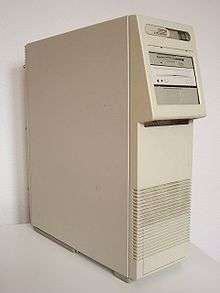Compaq SystemPro

The SystemPro from Compaq, released in November 1989, was arguably the first true PC based server. It supported Intel's 486 chip, a 32-bit bus, RAID disk and dual-processor support well before its main rivals.
Innovative features
The SystemPro, along with the simultaneously released Compaq Deskpro 486, was one of the first two commercially available computer systems containing the new EISA bus. The SystemPro was also one of the first PC-style systems specifically designed as a network server, and as such was built from the ground up to take full advantage of the EISA bus. It included such features as multiprocessing (the original systems were asymmetric-only), hardware RAID, and bus-mastering network cards. All models of SystemPro used a full-height tower configuration, with eight internal hard drive bays.
Multiprocessing

At its initial release in November 1989, the SystemPro supported up to two 33 MHz 386 processors, but early in 1990 33 MHz 486 processors became an option (the processors were housed on proprietary daughterboards). Because the system was asymmetric, 386 and 486 processors could be mixed. Single processor configurations were also available.
The only operating system which fully supported the SystemPro's asymmetric multiprocessing was a custom version of SCO Unix, sold by Compaq. However, when running OS/2, certain applications (notably Sybase SQL Server) could be offloaded to the second processor, and later, Novell NetWare SFT-III was able to offload its I/O engine. It is worth noting that the original versions of Windows NT (3.1) included a hardware abstraction layer specifically for the SystemPro; despite NT's symmetric multiprocessing design, this HAL could offload some kernel tasks to the second CPU. This made Windows NT 3.1 the only version of Windows to support multiprocessor 386-based machines.
System/Memory Architecture
The system used a state-of-the-art shared memory bus design, called Tri-Flex Architecture, to facilitate its multiprocessing capabilities. The original SystemPro shipped with 4MB 80ns DRAM, expandable up to 256MB using proprietary memory modules.
RAID

The SystemPro also offered one of the first implementations of RAID (including RAID 5) available on a PC-based system. The original RAID card, called the IDA (Intelligent Drive Array) used a proprietary form of IDE, supporting up to 4 drives internally. At its release, the largest drive available was 210 MB. Two IDA cards could be installed, allowing all 8 hard drive bays to be filled (each IDA controller array would appear as a separate logical drive to the operating system, however), providing a grand total of 1.2 GB using RAID 5, or 1.6 GB using non-redundant striping (RAID 0). Another option called the IDA Expansion Array provided support for up to 7 drives in a single array (housed in an external tower chassis looking virtually identical to the SystemPro itself), using an early (and very proprietary) form of differential SCSI. Note that all hard drives in the SystemPro or the Expansion Array were internally mounted drives; hot swapping was not an option.
Market
The SystemPro was marketed for those who had scaled up to the top end of LAN hardware, or those who were scaling down from minicomputers — and its pricing was set accordingly. At the time of launch, the "low-end" SystemPro (a single 33-MHz 386 CPU, 4 MB RAM, and two 120-MB hard drives) listed for $15,999 (USD); the same machine with 840 MB of storage (four 210-MB hard drives) listed for $25,999 (USD). A second 386 processor card cost $3,500 (USD), and an additional 32 MB of RAM was $21,999 (USD).
Legacy
The SystemPro line continued for several years, ending with the SystemPro XL (the only model that supported symmetric multiprocessing). It was replaced by the Compaq Proliant line, which introduced hot swappable drives and the rack mount chassis now popular in data centers. However, the SystemPro is notable for having established the PC-based server market, and setting a high-water mark for the servers that followed.
References
- Edward Foster; Patrick Dryden (13 November 1989). "Compaq Server Invades Mini Turf". InfoWorld. Vol. 11 no. 46. pp. 1, 5–6.
- Michael J. Miller (18 December 1989). "Systempro Really Shines As Network File Server". InfoWorld. Vol. 11 no. 51. pp. 1, 8.
- David Greenfield (30 June 1993). "Super Servers: Power, Reliability, Security—At What Price?". PC Magazine.
- Step Back in Time to 1988: Gary Thome on YouTube
- Step Back in Time to 1988: McGraw on YouTube
- http://www.pcmag.com/article2/0,1759,1179817,00.asp
- http://xrint.com/patents/us/5450609
- A posting to USENET at the time of the launch
- Another USENET posting at the time
| ||||||||||||||||||||||||||||||||||||||||||||||||||||||